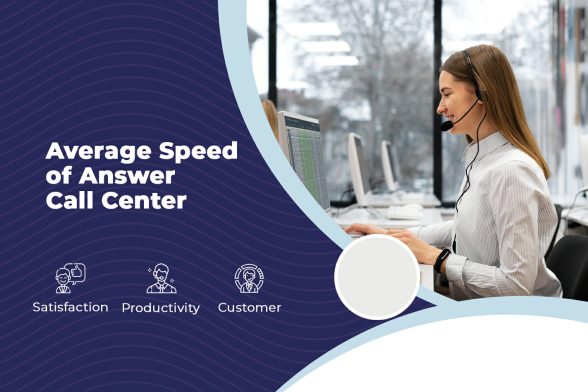- Resources
- ASA Call Center: Enabling prompt call center service
ASA Call Center: Enabling prompt call center service

If customer satisfaction is a crucial call center metric for your business, how quickly your agents answer the phone should be a top priority.
We have all been on the other side of that phone line, waiting for the IVR to stop repeating itself and for a human being to ask, “Hello, how may I help you?” As a customer, there is nothing more frustrating than waiting endlessly in the hold queue.
It’s little wonder that the Average Speed of Answer is one of the most critical contact center metrics.
What is ASA?
The average speed of answer (ASA) is the time an agent takes to answer your call. It includes the time a caller waits in a queue (also known as Average Wait Time) but does not include the time callers spend on an IVR.
ASA is a call center metric that directly affects the customer service experience and satisfaction levels.
What is Average Agent Speed of Answer (AASA)?
Average Agent Speed of Answer (AASA) indicates how fast call center agents answer inbound calls. This metric starts when the minute an agent’s phone rings and ends when the agent answers. It doesn’t include a customer’s time in the IVR or waiting in a queue.
Average Agent Speed of Answer is a call center productivity metric that directly influences the ASA or Average Speed of Answer.
How Do You Calculate the Average Speed of Answer?

To calculate ASA, you divide the total wait time for all calls by the total number of calls in a day.
ASA (in seconds) = Total waiting time for calls answered daily / Total number of calls answered in a day.
For example, if the total wait time for callers in a day is two hours or 120 minutes, or 7,200 seconds, and the total number of calls answered in the day is 200, then the ASA equals 36 seconds.
ASA = 7,200/200 = 36 seconds
The results of the above example tell you that, on average, a customer who calls your contact center waits for 36 seconds before they can speak to your customer service representative. Although less than a minute, 36 seconds can feel like forever to a customer in a hurry or an irate customer with a big issue.
What is the Importance of Call Center ASA?
ASA is a critical component of your overall customer experience. It is one of several variables that can help determine the success of the overall inbound call process. This KPI measures caller waiting times – a factor that directly impacts customer satisfaction outcomes.
The aim of a cloud call center software should always be to keep the ASA to a minimum. The faster your contact agent answers a call from a customer, the better it is for your business!
As a result, improving your call center ASA can lead to:
- Higher customer satisfaction. It gives a customer immense relief to hear a human voice answer because they feel closer to resolving their problem. And the faster they hear that voice, the more they appreciate your attentive service. Faster ASA can go a long way in calming an irate customer and rebuilding trust and customer loyalty.
- Improved agent productivity. If an agent answers a call quickly, the call queue moves faster, resulting in agents handling a higher number of calls. A lower ASA improves agent productivity and can lower the contact center’s operating costs. Also, the chances of resolving customer issues are better with a low ASA.
- Reduced customer attrition. Customers often hang up simply because the waiting time is too long. Long wait times are cited as one of the top reasons for poor customer service experience. Customers not only abandon the call but may end up abandoning your product or service. Lowering the number of dropped calls can reduce the customer attrition rate. Maintaining a low ASA is an excellent way to hold on to customers.
What is Average Agent Speed of Answer?
Average Agent Speed of Answer— also known as Average Delay or Average Agent Pick-up Time —is the amount of time an agent takes to answer a call.
What is the Call Center Industry-Standard for Average Speed of Answer?
In a comprehensive study conducted in 2021 across 24 million calls, we noted that the Average Speed of Answer was 46 seconds, a good industry benchmark. The Average Agent Speed of Answer for 2021 was 8 seconds across industries.
Below is a chart showing average queue times (aka ASA) and AASA across industries

When comparing ASA for 2021 versus 2020, we see that the Average Agent Speed of Answer has remained the same. In contrast, the ASA, or average wait time, has increased for the same period, indicating that call centers may need to increase staffing. We also see that eCommerce seems to be setting the benchmark for prompt customer service with average wait times at 22 seconds and average agent speed of answer as low as 2.3 seconds.
How Can a Call Center Improve Its Average Speed of Answer?
Improving the ASA metric involves streamlining the inbound call process. The availability of adequate skilled agents and well-planned call routing is crucial.
Three Key Ways to Improve a Call Center’s ASA
1. Use auto-answer.
Landlines or mobile phones take up to 6 seconds for call ringing. VOIP and softphones instantly get the call to agents using the auto-answer feature and can reduce your ASA from 8 seconds to 1-3 seconds.
In fact, in 2019, the Average Agent Speed of Answer across call centers dropped from 6 seconds to 3.6 seconds due to switching to auto-answer technology.
2. Improve agent training.
Agents should be familiar with their dashboards and receive training to help them wrap calls and answer faster. Proper preparation and motivation will help them get through the queues faster, naturally leading to higher availability and faster answer speeds.
Also read: How to reduce After Call Work
3. Accurately forecast call volumes.
View call center reports examining call volumes by day, time, and time of year. Use historical reports to predict your call center volumes and ensure that you have an adequate number of agents available to answer calls.
4. Utilize skill hunting.
Skill hunting involves dividing your workforce into several skill groups or departments. Doing this can create a better match between your agents and a caller. Agents skilled at handling certain types of calls, for instance, billing-related queries, are likely to resolve callers’ questions faster. As a result, call queues move faster, reducing agents’ overall loads and leading to a faster ASA.
5. Put your IVR to work.
A well-designed IVR can go a long way in reducing call volumes, accelerating call queues, and reducing the load on your agents. An effective IVR can lead to a faster speed of answer. For example, our client, a hospitality startup called Treebo, uses a CRM integrated call center solution to distinguish callers with prior bookings from other callers. The system directs existing customers to a live agent and offers a self-service menu to the other callers to connect them with a suitably skilled agent to meet their needs.
Another delivery firm also implemented a similar self-service IVR, resulting in the firm responding to customers three times faster than before. (Read the customer story here).
Conclusion
The speed at which a company answers a customer’s call is a significant part of establishing a good or bad first impression. That first call is a chance for companies to make a strong first impression for a lasting relationship. Answering calls quickly is also critical for nurturing an ongoing relationship and positive customer experience with existing customers.
Reduced wait times can go a long way in enhancing the customer experience. With some insightful analytics data and streamlined workflows, it’s well within reach!
Want to reduce the Average Speed of Answer and improve your customer experience in cost-effective, efficient ways? Learn about our inbound call solutions here.







